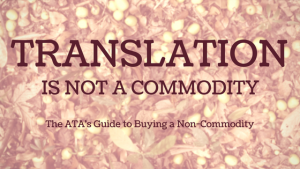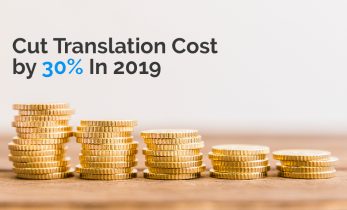Greater than 4 minutes, my friend!
Translation: Buying a non-commodity The ATA's guide to buying a non-commodity
What is a commodity?
Merriam-Webster defines it as:
1. : an economic good: such as
a: a product of agriculture or mining: agricultural commodities like grain and corn
b: an article of commerce especially when delivered for shipment: reported the damaged commodities to officials
c: a mass-produced unspecialized product: commodity chemicals; commodity memory chips
2. a: something useful or valued: that valuable commodity, patience; also: thing, entity
b: convenience, advantage… the many commodities incidental to the life of a public office … — Charles Lamb
4. : a good or service whose wide availability typically leads to smaller profit margins and diminishes the importance of factors (such as brand name) other than price
5. : one that is subject to ready exchange or exploitation within a market … stars as individuals and as commodities of the film industry. — Film Quarterly
Does translation fit any of these definitions?
The answer is no. In the resource linked to this post, the ATA’s publication tells us that:
“Translation is not a commodity.
If it were, it would be enough to say: “You need a translation? Go out and ask several translation service providers how much they charge per word and choose the lowest figure.” End of story.
But it’s not like that. For example, you’ll obviously need to specify which language you want your text translated into (e.g. French or German
or Japanese).And just as color and price are not the only factors in buying a car, you’ll want to consider other criteria here, too.”
What are the criteria?
- The type of document being translated.
- The subject-matter expertise needed by the person doing the translation.
- The intended readers.
- The purpose of the translation.
- The regional variation of the target language.
Any business person understands that in a client/vendor relationship there must be an agreement. A set of things, rules, understanding that both parties agree to uphold. If you are a manufacturing business, you agree that you will deliver the product to your client’s specifications. If you are a janitorial service, you agree to take care of the areas specified and perform the tasks requested. As a recipient of these services, you agree to pay on time, if you do not provide details of what you need, your vendor will not be able to perform that task accordingly. Why should it be any different with a translator?
Translators and interpreters (T & I) are service providers as well. As T & I professionals, we also adhere to a set of standards. These are some that you, as the consumer, should take into consideration:
- Select the right T & I for your project. On what languages are you focusing? The industry has an array of professional working in different language pairs.
- Agree on your project specifications before starting your project.
- Follow these specifications throughout the project.
But, what kind of specifications are we talking about?
You ought to consider the following:
- As with any other marketing strategy, who is your target audience?
- What is the purpose of this translation? Is it for a website, an employee manual, or instructions for your product?
- What is your deadline? Remember, you did not create this content overnight, therefore, allow your translator sufficient time to deliver a top-notch product.
- What is your budget? You and the translator must agree on the price. Remember cheaper is not always better. A professional translator is putting thought and time into your project, doing research, asking questions, editing, reviewing, to ensure that you receive the best product that your business deserves.
- What is the subject or topic of your translation? It is always best to find a translator that has worked on similar projects and/or has working experience in that area. Is your project a chemical engineering presentation? If so, you want to find someone who understands that area of expertise. Is your translation a literary work? There are translators whose focus is this particular area.
- What is the format of your source document? It is always ideal to submit an editable format because it will significantly help your translator get an accurate word count and start working right away. Note that PDF documents will sometimes cost more because your translator needs to convert the file to an editable format.
- What is the volume of your project? Many translators charge per source word which can be a factor in your final cost.
- Be specific on which target language you want to focus. Stating that you want a translation into Spanish may not be enough. Especially if your market is a particular country, like Mexico. Spanish from Mexico is not the same as Spanish from Colombia or Puerto Rico. Many words and terms can be deemed very offensive if the right region is not specified. Just like the English spoken in the US is not identical to the English in Great Brittain or New Zealand, other languages also have their variations. If your audience is here in the US, then be sure to specify that as well. The translator will then try to find more “neutral” dialect that may be more widely understood.
Of course, there are always more details you may offer to your translator. These are simply the most common, and it should allow you to determine how to communicate with your provider.
To obtain more information, follow the link in this article and read the ATA’s guide: “Translation: Buying a non-commodity. How translation standards can help buyers & sellers”
[Derived from ATA’s publication: “Translation: Buying a non-commodity. How translation standards can help buyers & sellers”] [This article was originally published in Context in Translation’s “Resources” page.]





Hello Ginna Ma, great article on client education. I have to daily communicate with my clients on this same issue, especially when they offer a large project of more than 100k words and ask for heavy discounts. I have to tell them that offering a large project does not relieve us of our effort. but, like you said aptly, they consider this service as a commodity and thus hope that buying in bulk would attract heavy discounts.
Thank you for your feedback, Priyank. So true. We still need to review the content, translated, etc. I would suggest occasionally sending some of your clients “complementary” ATA publications or a quarterly email with selected articles to help them understand our profession.
Thanks Ginna. I was thinking to add your article link to my quotation template. 🙂
That would be awesome! Thank you!
Well said, Ginna! We can be such valuable contributors to our clients’ work… if they only knew that! 😉
Thank you, Eleonora
Please, feel free to share. Also, if you’re interested, my website’s “Resources” page contains articles aimed at client education. Feel free to browse and share.
link to contextintranslation.com
Thanks, Ginna!